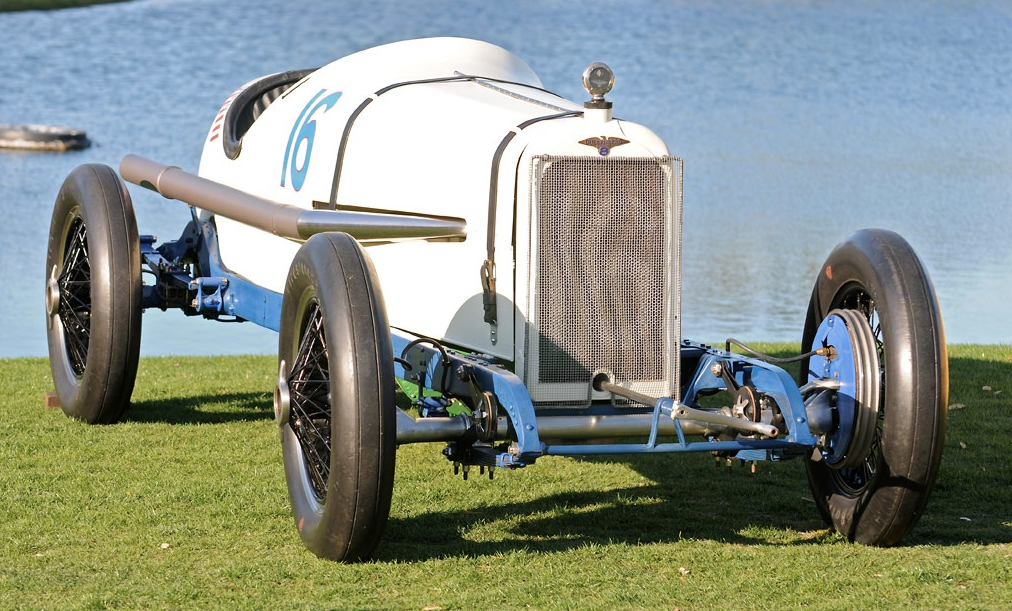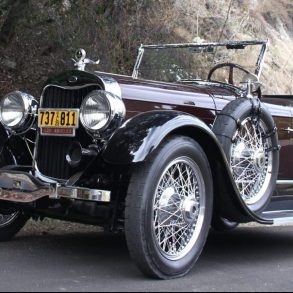Duesenberg 1921 GP
Car: Duesenberg 1921 GP/ Engine: 8-Cylinder In-line / Maker: Duesenberg / Bore X Stroke: 63 mm X 117 mm / Year: 1921 / Capacity: 2,980 cc / Class: Grand Prix / Power: 115 bhp at 4,250 rpm / Wheelbase: 105.5 inches / Track: 51 inches front, 51 inches rear / Weight: 2,001.8 lbs
Fred and August Duesenberg started building cars in 1907. Known as Masons after their financier of the same name they were powered by a 24 hp flat-twin engine. The Mason company was purchased by Frank Maytag, of appliance fame and had its name changed to Mason Maytag in 1910. The firm was also moved from Des Moines to Waterloo, Iowa. From the start the brothers were interested in building racing cars but when the owners of Maytag decided to curtail their racing efforts they left the firm and set up their own shop.
Many of Fred’s achievements were possible due to the efforts of his younger brother August S. Duesenberg. In 1913 Fred and Augie established the Duesenberg Motor Co. in St. Paul MN. At this point, they were building, testing, and developing both marine engines and complete racing cars. In 1914 they entered two cars in the Indianapolis 500, one of them driven by Eddie Rickenbacker. While doing no better then 10th place in the 500 they were able to win several smaller races. The war brought many lucrative developing marine, aircraft, tractor, and automobile engines. Great Britain, Italy, and Russia all used equipment from Duesenberg and wartime advertising stressed “Power of the Hour”. One early Duesenberg motor was called a Walking Beam. The Walking Beam used long rocker arms at the side of the motor, which activated horizontal valves in the head. The other end of the rocker arm was activated directly by the lobes of the camshaft.
After the war they fielded a 5 car team for the 1919 Indianapolis 500 but the race proved to be a disaster. Two of their drivers and one mechanic were killed and all five cars failed to finish the race. The next year they had greater success when Duesenbergs came in 3rd, 4th and 6th. In 1921 they would make history when Jimmy Murphy headed a team managed by 1908 Vanderbilt Cup winner George Robertson to the French Grand Prix. Dismissed by the European teams, the Duesenbergs came in 1st, 4th and 6th. Jimmy Murphy, rebounding from injuries suffered during a crash in practice beat the best that Europe had to offer and became the only American driver in a car built in the United States to win the French Grand Prix.
Jimmy Murphy would later purchase the car and have it re-engined with a Miller. The new car christened the Murphy Special won the 1922 Indianapolis 500. The race was dominated by Duesenbergs taking 8 of the top 10 finishing positions. The Duesenberg Model A passenger car was based upon the racing machine and was considered one of the very finest in the world.
Though the new passenger cars were well received they would not stop both Duesenbergs from continuing their racing efforts. The continuing rivalry with the difficult, eccentric Harry A. Miller, whose Los Angeles based company was producing major advances in pure racing cars and engines produced major advances in supercharging, front-wheel drive, cylinder-head design, suspensions, brakes, and myriad technical details.
But for all their mutual successes, both organizations would be driven toward financial disaster by racing. Miller, who was even more inept at business than the Duesenbergs, went in and out of bankruptcy in the early 1930s, and while he remained active as a designer and builder until his death in 1943, he never regained the glory years of the twenties.
Duesenberg was acquired by Erett Lobban Cord who built the Auburn-Cord-Duesenberg combine. Cord had also been attracted by the brothers’ engineering prowess and saw through them a path to his dream of building an unrivalled luxury car. Fred was given an assignment – build the best car in the world. More than a competitor for Cadillac or Packard, it was intended from the outset to be better than Rolls-Royce, Hispano-Suiza, Isotta Fraschini and Bugatti.
The Duesenberg Model J and later SJ lived up to Cord’s expectations. Fred Duesenberg was struck down from pneumonia in 1932 brought about by injuries suffered from a road accident. By mid-1937 the Auburn-Cord-Duesenberg empire plunged into receivership. Augie remained close to the sport he loved and was a fixture at the annual Indianapolis 500 until his death in 1955.















